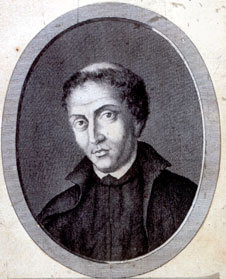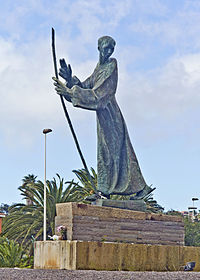Joseph of Anchieta
A highly influential figure in Brazil's history in the first century after its European discovery, Anchieta was one of the founders of São Paulo in 1554 and of Rio de Janeiro in 1565.With his book Arte de gramática da língua mais usada na costa do Brasil (1595), Anchieta became the first person to provide an orthography to Old Tupi, the language most commonly spoken along the coast of Brazil.[3] Anchieta was born on 19 March 1534, in San Cristóbal de La Laguna on Tenerife in the Canary Islands, Spain, to a wealthy family.He had escaped to Tenerife in 1525 after participating in an unsuccessful rebellion against the Emperor Charles V. Through him, Anchieta was related to Ignatius of Loyola, founder of the Society of Jesus.In late 1553, Manuel da Nóbrega, the first Provincial of the Jesuits in Brazil, sent 13 Jesuits including Anchieta to climb the Serra do Mar to a plateau along the Tietê River that the Indians called piratininga (from Tupi pira "fish" + tininga "drying" – according to Anchieta, more than 12,000 fish could be found drying along the Tietê River floodplains after one of its customary floods).[8] Anchieta and his Jesuit colleagues began their efforts to instruct the native people in the rudiments of Christianity and convert them, while also introducing basic education in other subjects.He later praised the colony's third Governor General, Mem de Sá (1500–1572), for what he accomplished in eliminating cannibalism, even though it was done by killing large numbers of Amerindians.[10] Due to the systematic killings and ransacking of their villages by Portuguese colonists, together with attempts to enslave them, the Indian tribes along the coast of the present-day states of São Paulo, Rio de Janeiro and Espírito Santo rebelled and formed an alliance, the Tamoyo Confederation.Anchieta and Nóbrega initiated peace negotiations with the Tamoyo in the village of Iperoig in modern Ubatuba on the northern coast of São Paulo state.His reports establish him as an ethnographer, though he focused on Amerindian behavior that did not follow European norms, such as their choice of marriage partners, cannibalism, and the role of sorcerers.[14] He detailed the practice of polygamy and, because it had produced dense networks of interrelations, advocated easing the church's consanguinity rules to allow all but brothers and sisters to marry.It presents de Sá as "a Christian Ulysses determined to oust Satan" who "presides ... over hordes of demonic Amerindians, creatures devoted to dismembering bodies".[18] His dramas, written in a combination of Tupi, Portuguese, Spanish, and Latin, were not meant for the stage but for performance by local amateurs in village squares and churchyards.[13] Few of his plays survive, but those that do have been praised, despite being crafted for a local audience with a didactic purpose, for their "remarkable feeling for spectacle, calling for the use of body paint, native costumes, song and dance, fights, torches, and processions".[18] A performance might even call for cannon fire from a nearby ship, though the plays were typically "short on action and long on explanations of doctrine" and characters fall clearly into positive and negative types.It was a gift from the Government of Brazil to Anchieta's hometown, where a wooden image of him is also venerated in the Cathedral of La Laguna and carried in procession through the streets every 9 June.In the Basilica of Our Lady of Candelaria (patron saint of the Canary Islands), there is a painting of José de Anchieta founding the city of São Paulo.


Spanish namesurnameBenedito CalixtoSan Cristóbal de La LagunaTenerifeSpanish EmpireReritibaGovernorate General of BrazilIberian UnionCatholic ChurchSociety of JesusBeatifiedSaint Peter's SquareVatican CityPope John Paul IICanonizedPope FrancisshrineCathedral of San Cristóbal de La LagunaNational Shrine of Saint José de AnchietaAttributesPatronagescoliosisChristogramRegimini militantisCongregatio de AuxiliisSuppressionGeneral CongregationSuperior GeneralSpiritual ExercisesAd maiorem Dei gloriamList of Jesuit educational institutionsNotable JesuitsIgnatius of LoyolaFrancis XavierPeter FaberPedro ArrupeJohn BerchmansFrancisco SuárezRobert BellarminePeter CanisiusEdmund CampionPierre-Jean De SmetAugustin BarruelAloysius GonzagaFrederick CoplestonKarl RahnerJesuit saintsJesuit theologiansCanarianJesuitmissionarycolony of BrazilEuropean discoverySão PauloRio de JaneirogrammarianCanary IslandsBrazilian literatureCatholicIndianManuel da NóbregaArte de gramática da língua mais usada na costa do BrasilorthographyOld TupiPeter of Saint Joseph de BetancurLa Laguna CathedralCasa AnchietaBasque CountryrebellionCharles VJew who had converted to Christianitykingdom of CastilePortugalCoimbraUniversity of CoimbraPortugueseHouse of José de AnchietashipwreckSão VicenteProvincialSerra do MarplateauTietê Riverfloodplainsconversion of Saint PauldictionarygrammarJesuit College of São Paulo of PiratiningaHuguenotMem de SáenslaveEspírito SantoTamoyo ConfederationGuanabara BayNicolas Durand de VillegaignonUbatubaTupi languageTupiniquimEstácio de SáPão de AçúcarinterpreterSalvadorEverard Mercurianprovincial superiorOscar Pereira da SilvaDe Gestis Mendi de SaaVirgin MaryLawrence of RomenaturalistgeographyPraça da SéAnchietaSanta CatarinaA.St.-Hil.ViolaceaeAnchieteaNey LatorracaMonument to José de AnchietaServant of GodPope Benedict XIVenerableJohn Paul IISanta MartaBishop of TenerifeBernardo Álvarez Afonso

